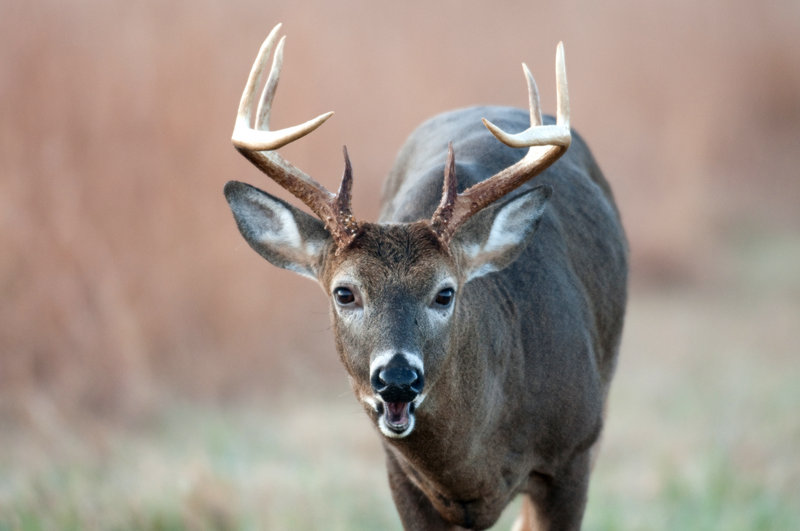Communication is often a key element to successful hunting. The process of turkey hunting is based largely on vocal communication. We try to call the birds by sounding like one of their own. And if you get good at it, you can be a fairly successful turkey hunter.
Many folks try to do the same thing with deer, but usually experience far less success.
Ever wonder why? Perhaps you’re not saying the right things. Just as with humans, subtle differences in tone, pitch or inflection could send a completely different message.
Maybe you’re not even speaking the right language. To us, a mouth-blown grunt tube might sound just like a deer; but to a deer it might sound more like a cheap party favor. Or perhaps, and more likely, you’re not even using the right mode of communication.
Because vocalization is our primary means of communication, we assume that must be the same for other members of the animal kingdom. But it’s not. When it comes to communication, it only makes sense for whitetails to make use of their keenest sense, their sense of smell.
Make no mistake, sound is important. Deer can hear fairly well, certainly better than us. They do make a few different grunts, bleats and snorts, all of which convey a fairly limited amount of information. And they no doubt can interpret certain postures or other body language, also probably better than we can.
It is their ability to produce and detect scents, however, that is the most sophisticated and most useful in communication.
For sending, they have no fewer than seven glands or glandular areas that secrete aromatic compounds. For receiving, they have a nose that some speculate may be 10,000 times as sensitive to odors as our own, plus a vomeronasal organ in the roof of their mouth that’s used to detect scent.
Biologists are still just beginning to unlock the mysteries of what information deer communicate through scent. We know, for instance, that interdigital glands — located between the toes — secrete volatile fatty acids that are deposited on the ground with each step a deer takes.
They signal that a deer has passed by recently. And because they evaporate at different rates, another deer encountering that scent can tell which way the deer that made it was traveling, and quite possibly how long ago it went by.
That alone is pretty impressive, until you consider that those glands actually secrete 46 volatile compounds, each of which could convey a different message. And they’re not even the most prolific glands.
During most of the year, a buck’s tarsal glands are relatively inactive. During the rut, they begin producing more scent-bearing fatty acids.
Rutting bucks also urinate on these glands as they rub them together. As a result the longer hairs on the hocks, where these glands are located, become dark stained and emit a strong, musky odor. Our simple interpretation is that the buck is in rut. Other deer may be able to tell his age, health and social dominance simply from his musky aroma.
Even more remarkably, he leaves that scent behind in bare patches of earth called scrapes as a way of telling all who pass by that he’s ready, willing and able to breed, and to kick the butt of any subordinate buck that tries to interfere with that objective.
That sounds like pretty sophisticated communication to me.
If you’re still not convinced, consider that the same scrape also has an overhanging “licking” branch. In the process of tending a scrape, the buck will also “work” that branch with his head, depositing scent from both his pre-orbital and forehead glands on it.
These almost certainly convey a slightly different message; otherwise there would be no need to perform this action in addition to rub-urinating. Furthermore, subordinate bucks and even does will work a licking branch, and may do so year-round.
Now consider that a deer’s body chemistry can change almost instantaenously. Alarm can cause a sudden release of adrenaline, which could, in turn, be disseminated through the interdigital or metatarsal gland, warning other deer of potential danger.
More subtle changes also occur as deer approach and enter the breeding season, even as they interact with other more dominant or subordinate deer. A simple whiff could transfer a billboard worth of information.
I’m not suggesting you should leave the calls at home in deference to scents. They can be effective tools under the right circumstances.
However, comparing them to scents and lures is about like comparing a telegraph to a cell phone. When properly applied, scents and lures can be extremely effective. You can sometimes increase their effectiveness by also using calls.
Bob Humphrey is a freelance writer and Registered Maine Guide who lives in Pownal. He can be contacted at:
sportventures@juno.com
Send questions/comments to the editors.



Success. Please wait for the page to reload. If the page does not reload within 5 seconds, please refresh the page.
Enter your email and password to access comments.
Hi, to comment on stories you must . This profile is in addition to your subscription and website login.
Already have a commenting profile? .
Invalid username/password.
Please check your email to confirm and complete your registration.
Only subscribers are eligible to post comments. Please subscribe or login first for digital access. Here’s why.
Use the form below to reset your password. When you've submitted your account email, we will send an email with a reset code.